There are many different kinds of edible berry bushes that you can grow in your garden or find in the wild. They all have their own unique characteristics. They are also often used for landscaping your yard.
Most edible berries in stores today were selected and adapted from wild species. They’re bred for their more concentrated flavor and higher nutritional content.
Some are very well known. You will certainly have heard about them. This includes raspberries, blackberries, and blueberries. Others might be more unfamiliar but not less interesting.
Let’s look at 13 of the most delicious and nutritious berries that grow on bushes to plant in your yard or garden.
- Related article: Edible Plants Guide
7 Key Takeaways on Edible Berry Bushes
- American red raspberries are easy to grow and very common. They are high in fiber and vitamin C.
- Common blackberries thrive on the Pacific coast. They are juicy and sweet, perfect for eating raw or in desserts.
- Salmonberries are found along the West Coast. They have a tart flavor and are best enjoyed with added sugar.
- Blueberries prefer wet areas and are common in the northern U.S. They are excellent in jams, pies, and breads.
- Cranberries are known for their use in Thanksgiving cranberry sauce. They are also known as a superfood rich in vitamins and antioxidants.
- Common elderberries are growing in the eastern U.S. and Canada. They require cooking before eating and are used to make syrups and juices.
- Goji berries come from China and are still new in the U.S. They are rich in antioxidants and nutrients.
What Are the Best Edible Berry Bushes for Your Garden?
Delicious berries are a treat for the senses. They offer vibrant colors, juicy textures, and sweet-tart flavors. Growing your own berry bushes brings these delightful fruits to your garden. It ensures a fresh and readily available supply.
This guide will explore the best edible berry bushes you can plant and enjoy in your backyard.
1. American Red Raspberries (Rubus strigosus)
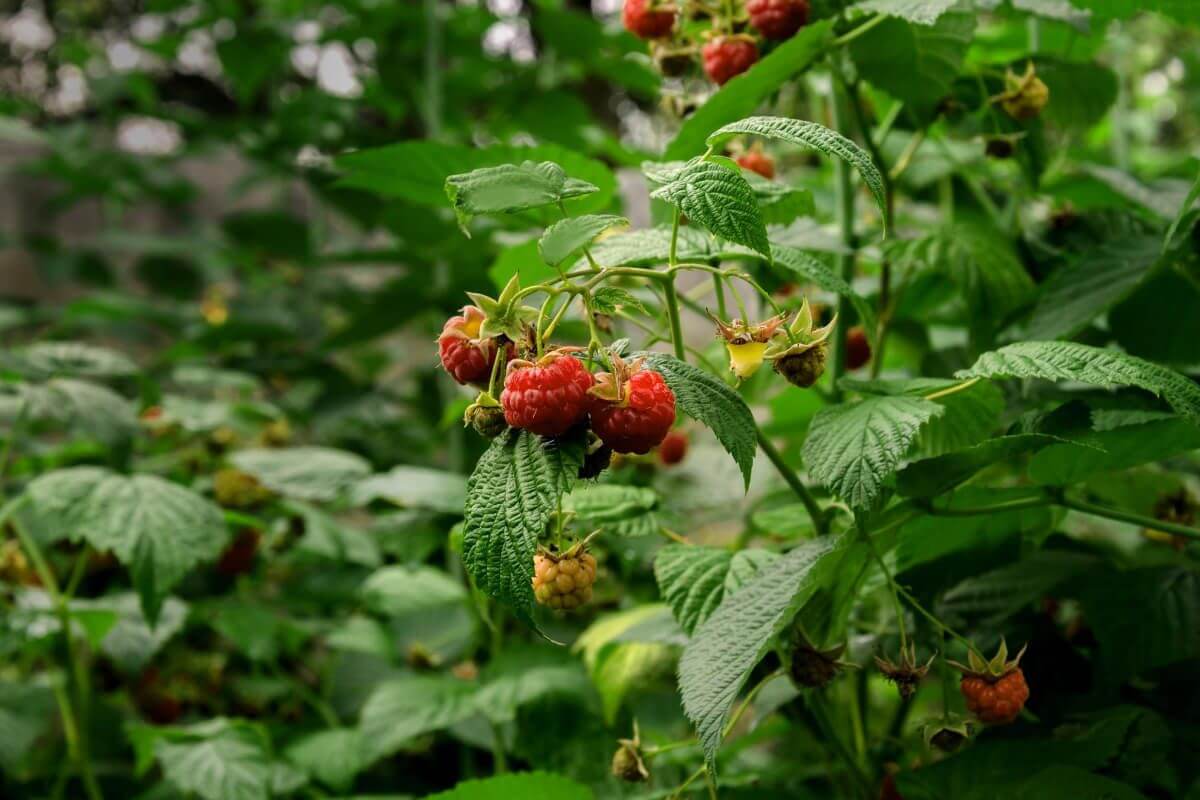
Raspberry is one of the most common and well-known berry shrubs in the wild and the easiest to grow. You can easily find it along trails or roads, and it grows mostly in the eastern part of the country. The top producers of cultivated raspberries are the states along the west coast.
Raspberries are excellent when enjoyed fresh. This is whether added to fruit salads, porridge, or cereals. These tasty berries can also be made into jams. Or they can be used as an ingredient in many preparations, such as pancakes and pies.
Raspberries are very healthy. They are high in fiber and vitamin C and low in calories. But be mindful when you pick them. Like the other berries of the Rubus genus, raspberry branches are covered in prickles.
2. Common Blackberries (Rubus allegheniensis)
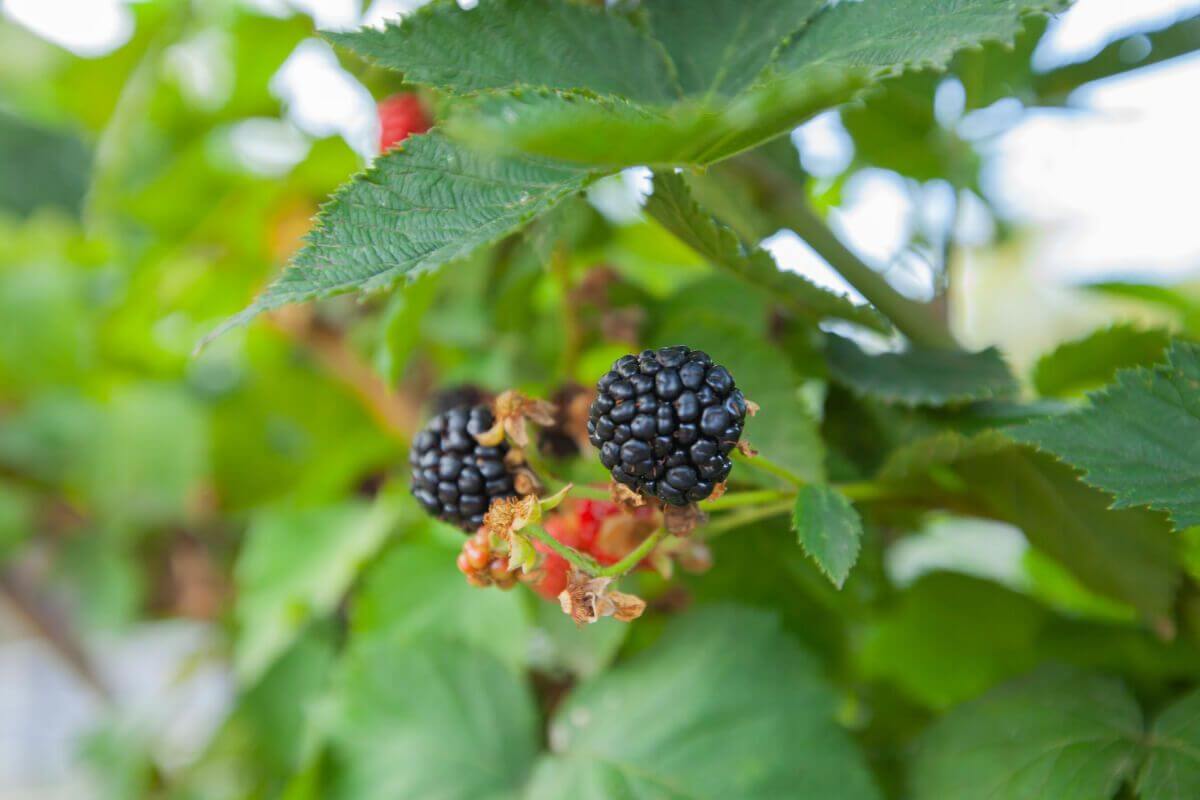
Blackberries are shrubs easily found in the margins of woods and abandoned fields. They are native to temperate areas. In the U.S., they grow mostly on the Pacific coast, much like raspberries. Tens of thousands of blackberry hybrids exist, as different species cross-breed easily.
Blackberries are juicy and have a sweet taste. They are commonly eaten raw or used to make desserts. They can also be used as a base for alcoholic beverages and candies.
Blackberries are like raspberries. They are one of the easiest plants to grow and yield excellently. They are packed with vitamins C and K and are high in manganese and iron.
3. Salmonberries (Rubus spectabilis)
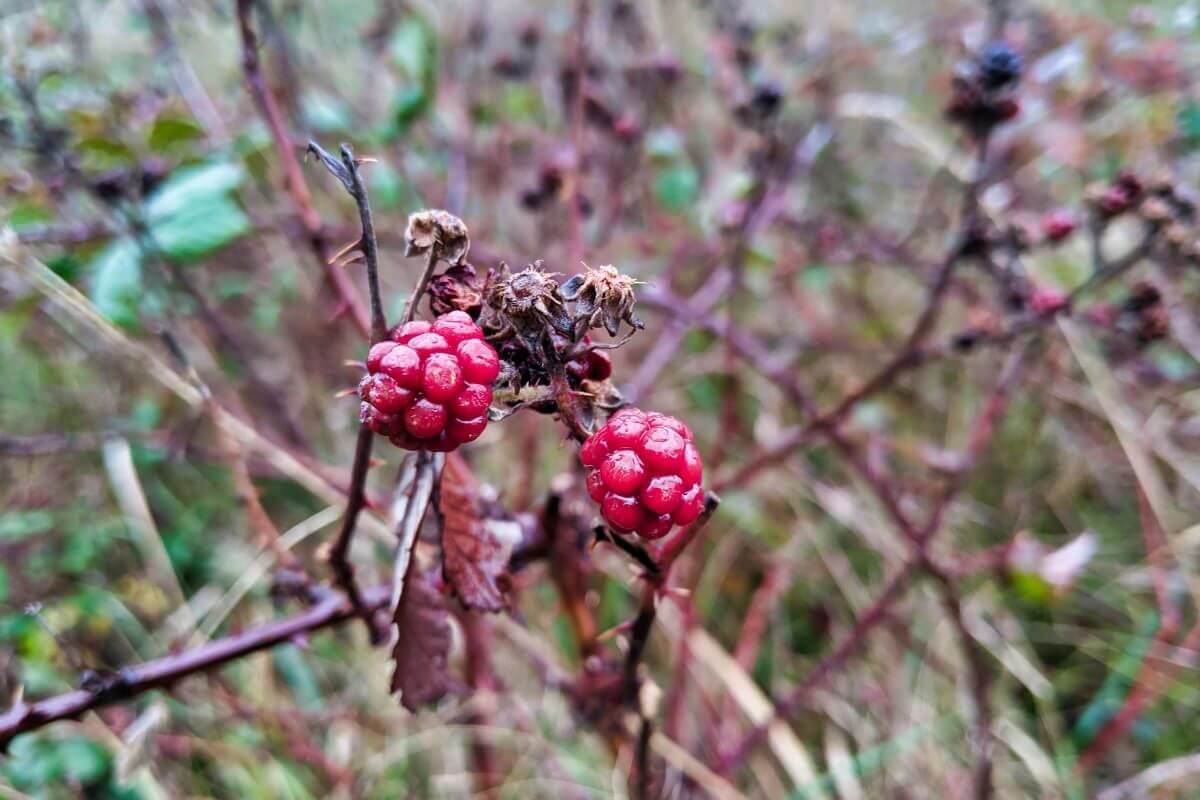
Salmonberries are common in the wild along the west coast and wet areas. They can be grown for food, but their main use stabilizes eroded soils. They are closely related to raspberries and blackberries and are similar in appearance. Their color is their defining characteristic, similar to that of salmon eggs.
Salmonberries have a tart flavor and large bitter seeds. They can be eaten raw, but they’re best enjoyed with sugar, such as in candies or jams.
These berries are rich in vitamins K and C and manganese.
4. Blueberries (Vaccinium species)
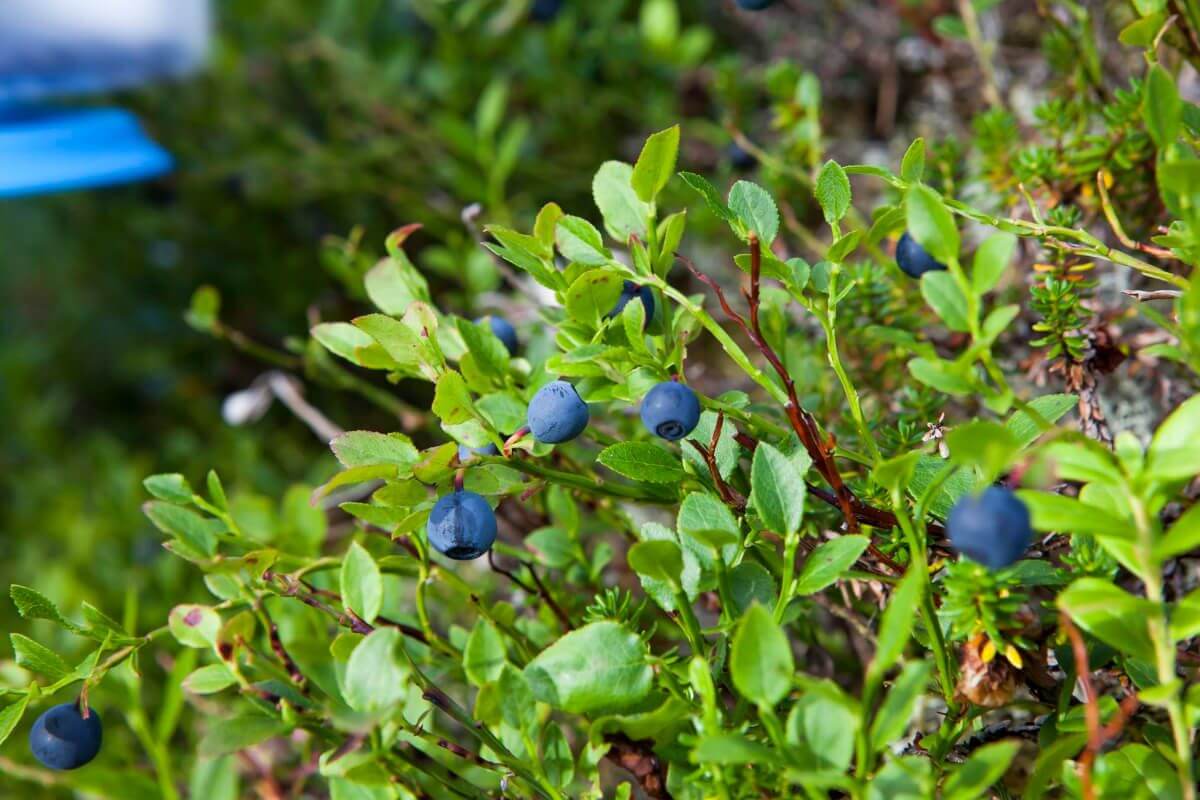
There are many different species of blueberries in the wild, and some are also cultivated. Blueberries prefer wet areas and are common in bogs and woods. Some species thrive at higher altitudes. They are typically found in the northern part of the U.S.
Blueberries are excellent in jams, pies, and breads but are also dried like raisins. Wild berries are generally smaller and tastier. They also have more antioxidants than the cultivated varieties. There are bigger ones, too, because they have a higher water content.
- Learn more about How to Identify Edible Wild Berries
Anthocyanins are the main antioxidants in blueberries. They are also responsible for the blue color.
5. Cranberries (Vaccinium macrocarpon)
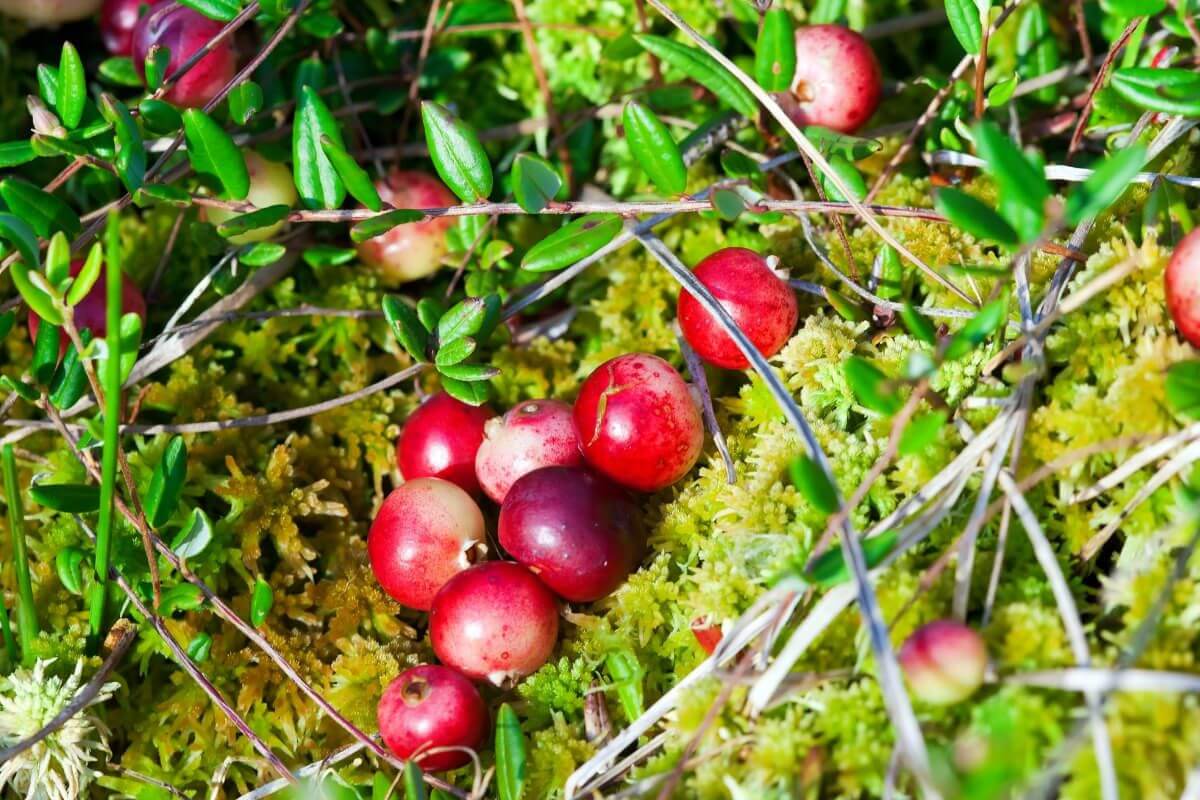
Cranberries are closely related to blueberries. Like them, they are widespread in the country’s northern areas. They thrive in bogs, swamps, and near lakes. Cranberries can also be grown at home by planting them in wet soil.
Cranberries can be eaten fresh or dried. They are famous for making Thanksgiving sauce. They’re also seen as “superfoods.” Rich in vitamins, they offer antioxidant benefits.
Cranberry fruits are resistant to cold and can sometimes be found throughout winter. Similar species have smaller berries and are also edible.
6. Common Elderberries (Sambucus canadensis)
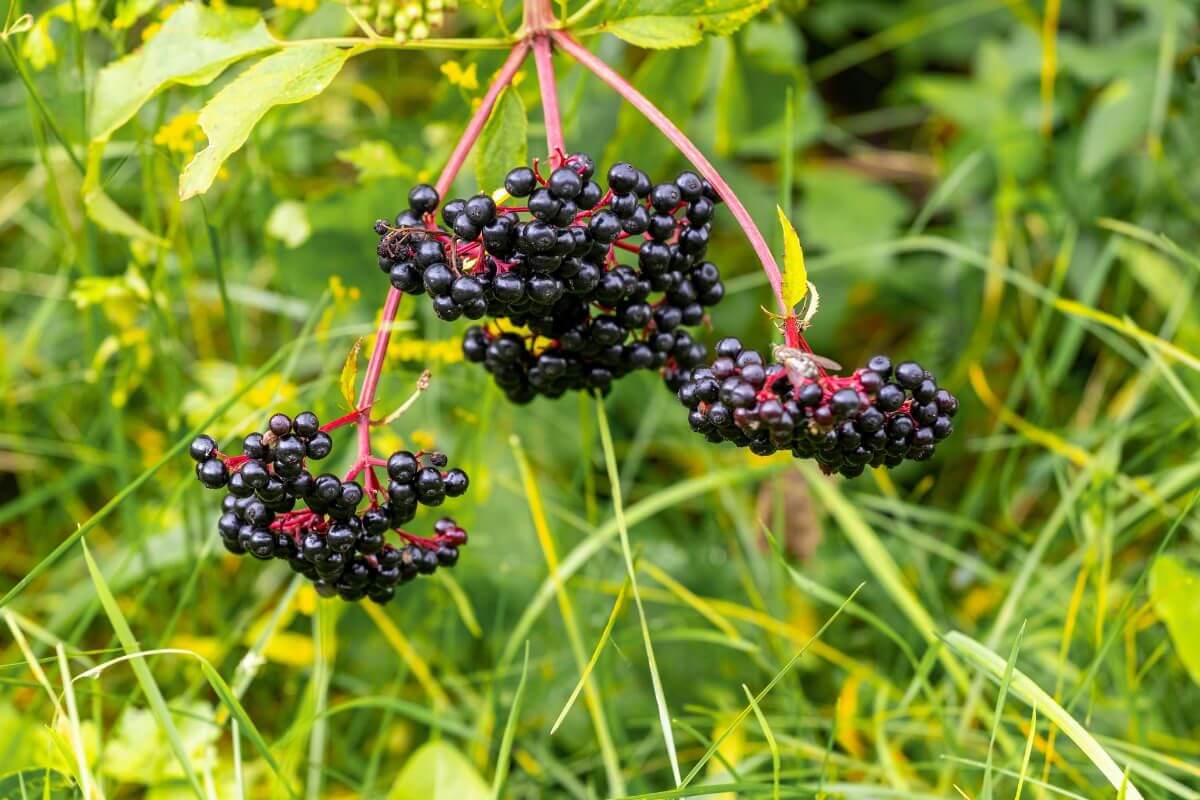
Elderberries grow both in the wild and planted in yards. They are common in the eastern United States and Canada. Look for them in woodlands and hedgerows.
Elderberry shrubs are easy to spot in the spring. They have lush, green leaves and clusters of small, white flowers. In the summer, they have dark, round berries.
The elderberry flowers and fruits are edible. But, the fruits must be cooked before eating. Otherwise, they can cause nausea. They have a tangy taste, which is very refreshing when they are used to make syrups and juices. Elderberry jam is also delicious.
Moreover, elderberries are very healthy, rich in vitamins C and B6, and antioxidants.
7. Chokeberries (Aronia species)
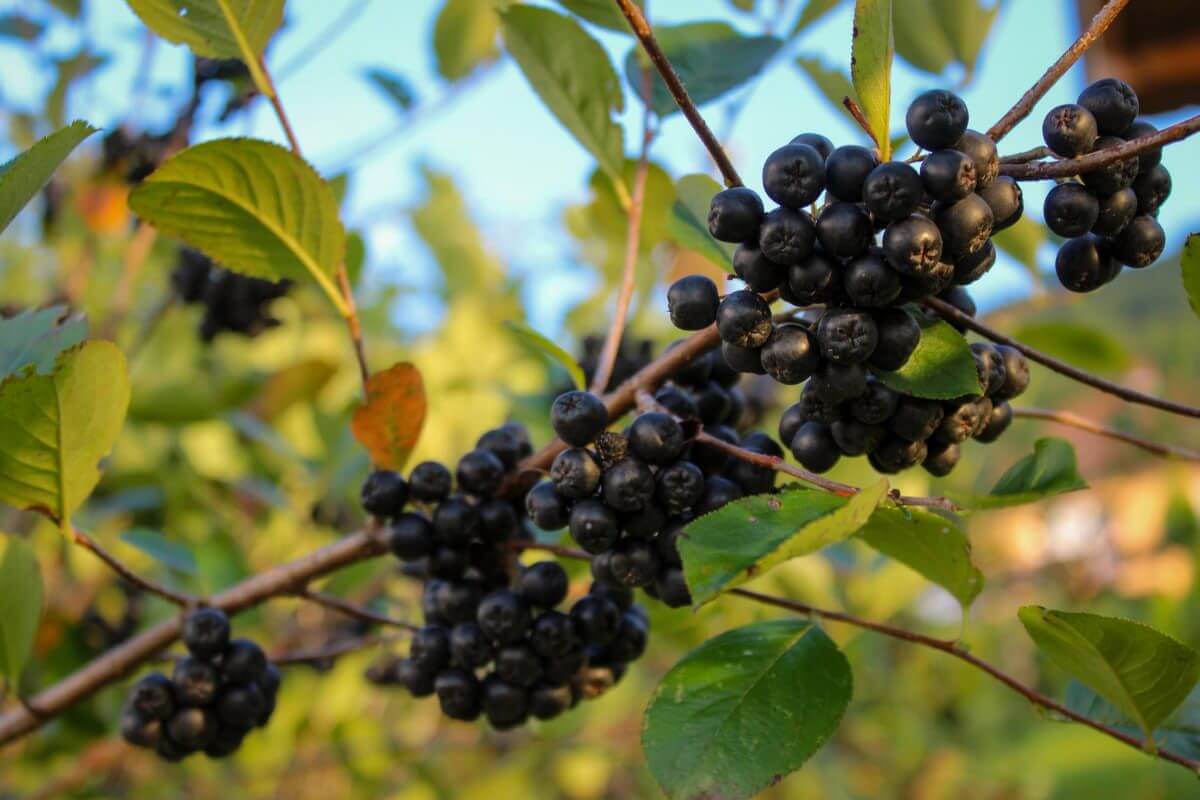
Chokeberries are easy to grow and occur in the wild, mostly in the eastern part of North America. They thrive on moist ground, in forests, or swamps. There are two most common chokeberry species. The one that bears black, tasty fruits (Aronia melanocarpa). The other with red, dry ones (Aronia arbutifolia).
Chokeberries can be eaten fresh if you enjoy their tart taste. Or they can be made into jams and berry juices if you have a sweeter palate. They are also used to make wine or tea.
They have recently become well-known because of their nutritional qualities. These fleshy berries are rich in antioxidants. They also contain small amounts of iron and calcium.
8. Buffaloberries (Shepherdia species)
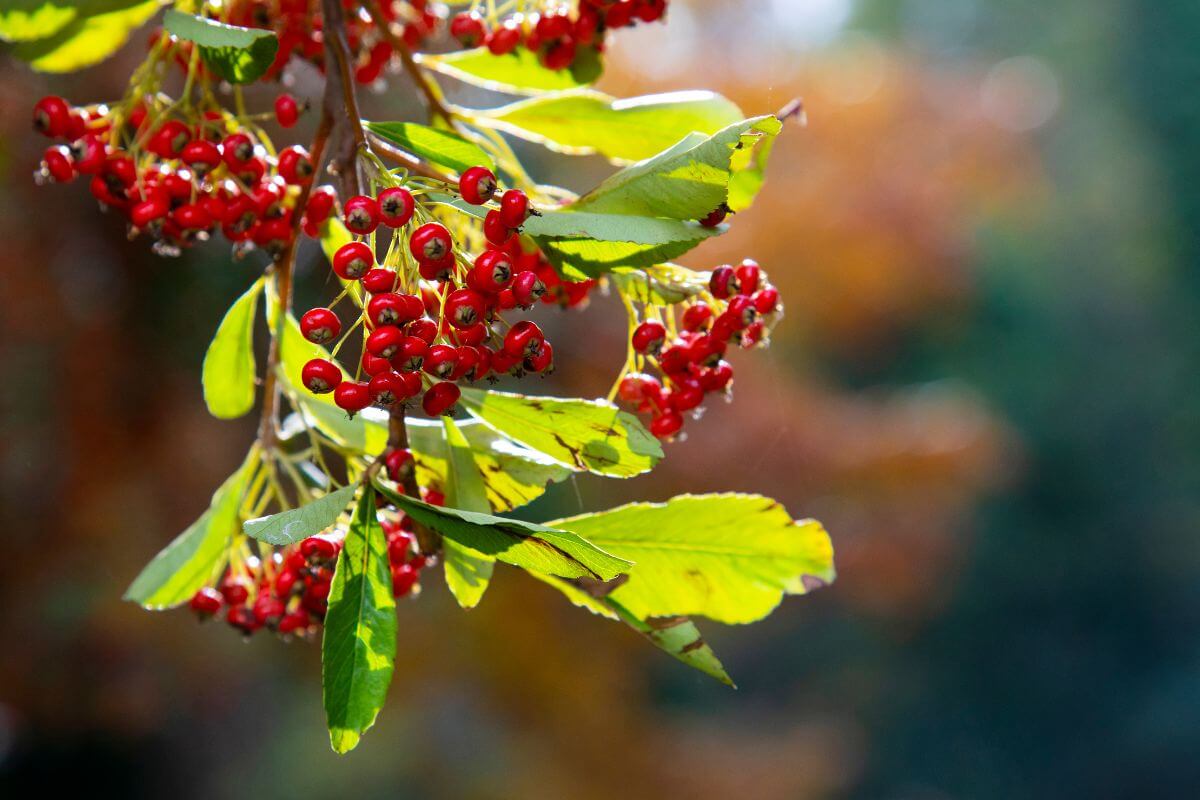
There are three main species of buffaloberries in the U.S. They are very difficult to tell apart but all are edible. Shepherdia is a good shrub to grow. It can thrive on poor soils where other plants lack nutrients. This is thanks to its ability to fix the nitrogen in the soil.
Yellow flowers come in June. You need a male and a female plant. Then, clusters of edible red berries with small dots or scales appear from August to fall.
- Read more about Edible Red Berries
Buffaloberries or bullberries are most often eaten in jams and sometimes syrups. They can also be consumed raw but are a bit bitter and tough to chew.
They are nutritionally interesting because they are rich in lycopene, a strong antioxidant. However, eating too many can cause intestinal problems.
9. Gooseberries (Ribes uva-crispa)
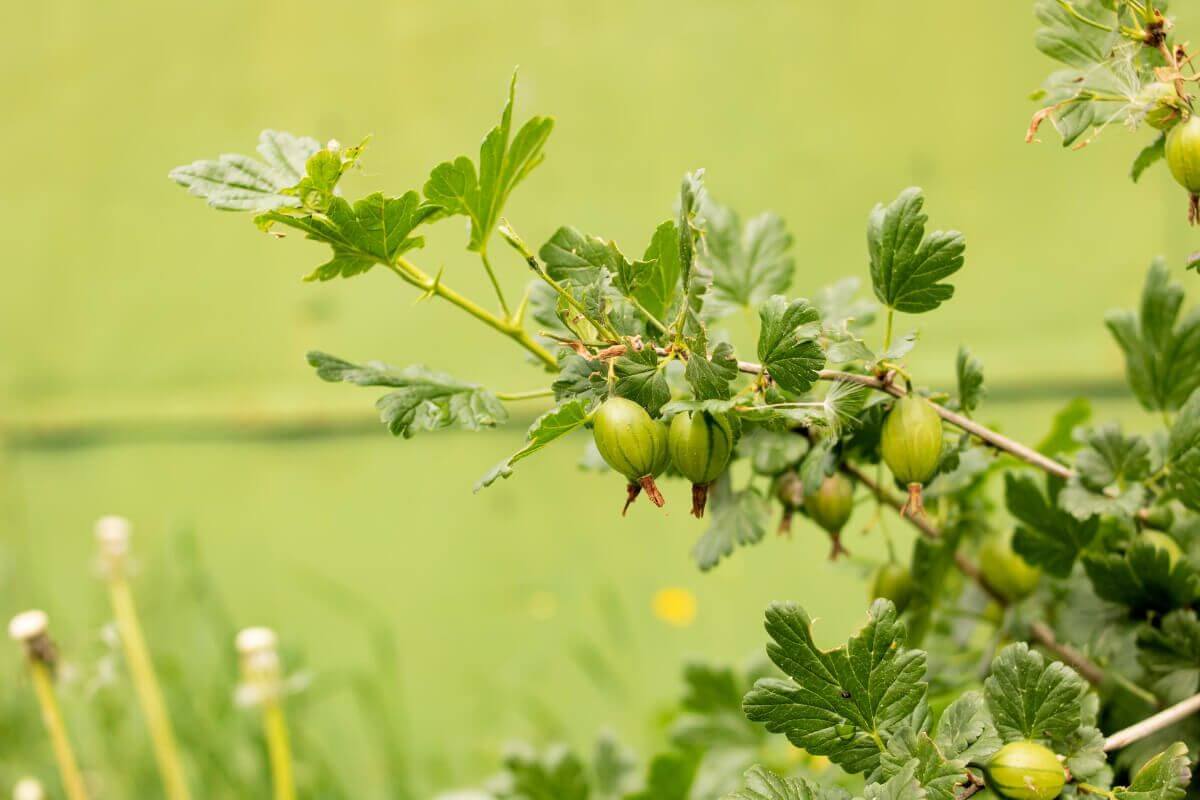
Gooseberries can be easily found in moist, shady areas in most of North America. They can be grown in the ground or in large pots, and they prefer moist soil.
They are easily recognizable thanks to their unusual appearance. They are covered in small spikes and can be green, orange, purple, red, yellow, white, or black.
Gooseberries can be eaten raw or cooked in jams or pies. Their flavor is quite similar to grapes but not as sweet. Different varieties can taste more or less sweet or tart.
This beautiful fruit contains vitamin C, antioxidants, and dietary fiber.
10. Rose Hips (Rosa species)
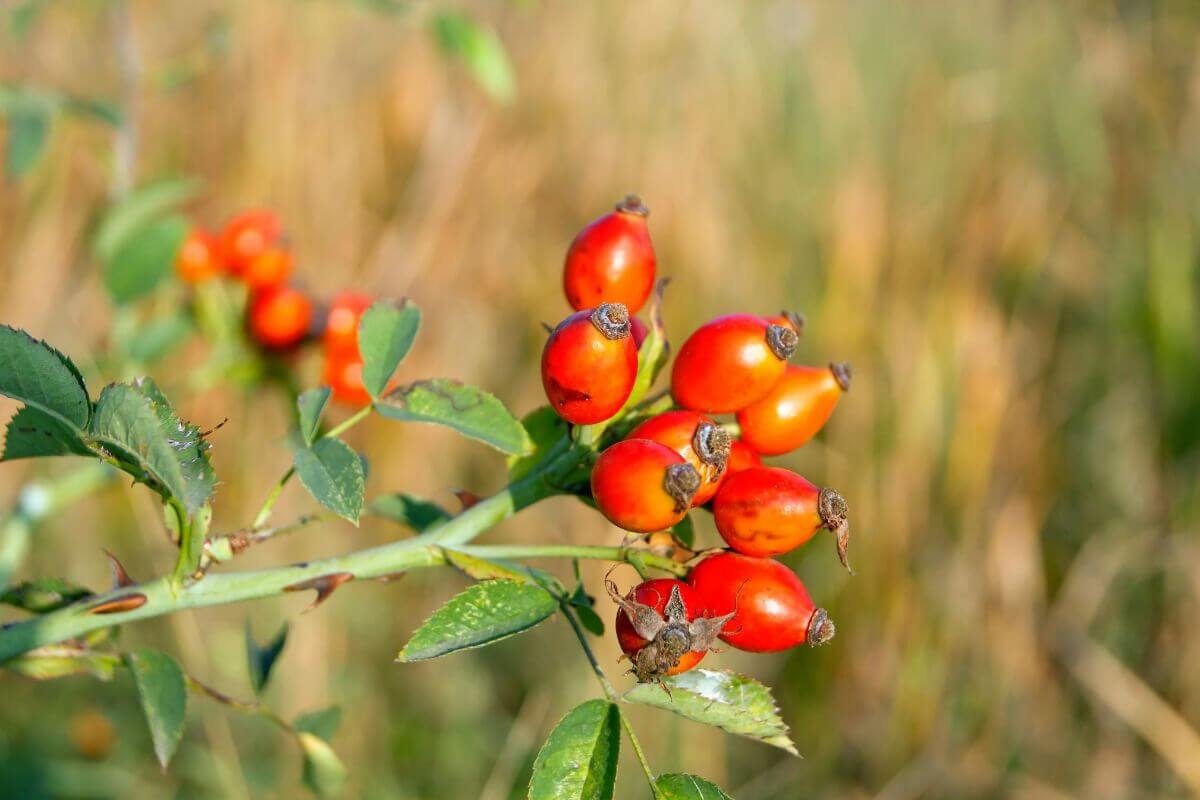
Rose hip berries are widespread in North America, both in the wild and as garden plants. Numerous species exist, all of them edible, including ornamental ones.
If rose hips are farmed for food, do not spray them with chemicals. This is to avoid eating harmful substances. Roses do not like plenty of sunlight.
Rose hips are tiny red fruits with hairy seeds. It’s best to discard these as they can be irritating to eat. Rose hips jams are very tasty but require patience and time to make. Alternatively, the berries can be eaten raw.
They are a great source of beta-carotene and malic acid. They also have a lot of vitamin C. Rose hips were used in ancient times to boost the immune system, lower blood pressure, and aid digestion.
11. Saskatoon Berries (Amelanchier alnifolia)
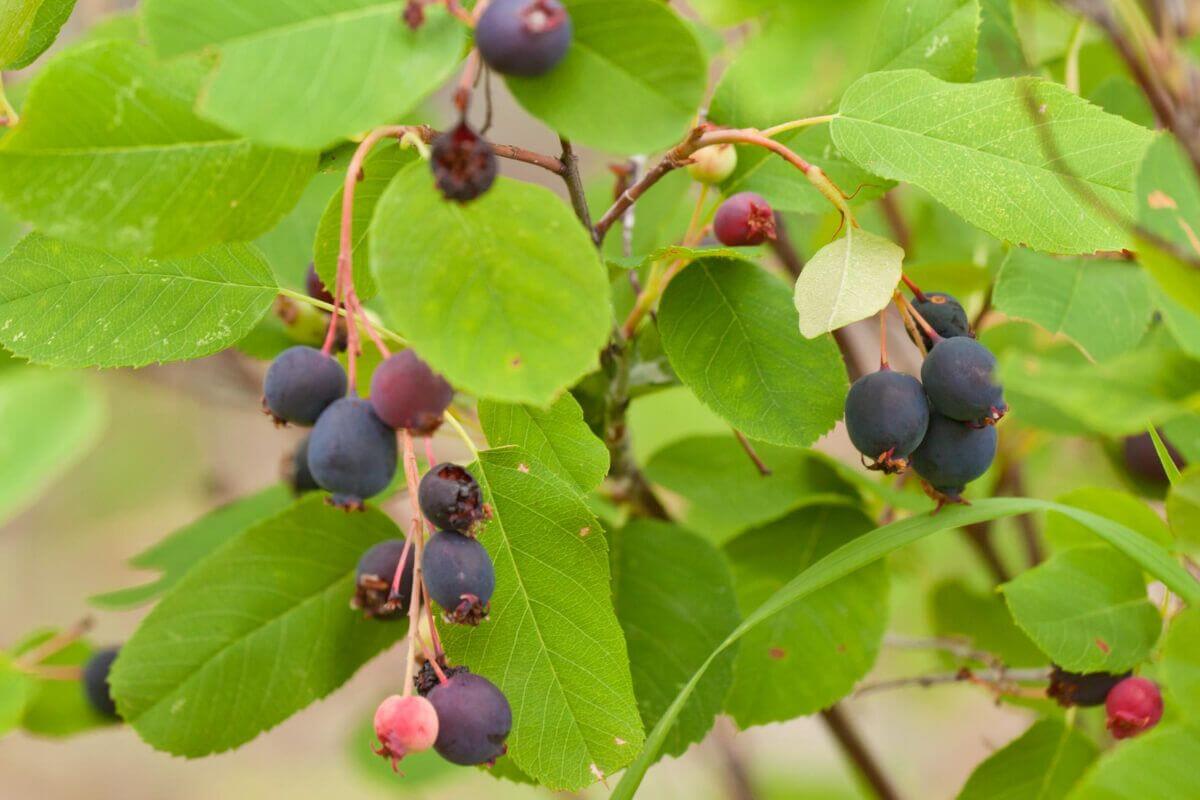
Saskatoons are commonly grown in the United States. They occur in the wild in the northern states and Canada. These shrubs can become quite tall, making the berries difficult to pick. Another difficulty is that birds love this edible fruit and often eat it all before it ripens.
To be safe, you can harvest them when they are pink. Don’t wait for them to become dark blue berries as they mature.
Saskatoon berries are very tasty. Some say they are better than blueberries in flavor. They can be eaten raw or used in a variety of preparations. Saskatoon jams and pies are common. But it’s also traditional to use them to make alcoholic drinks, like cider, beer, and wine.
Compared to other berries, Saskatoon berries have the highest vitamin B2.
12. Goji Berries (Lycium barbarum)
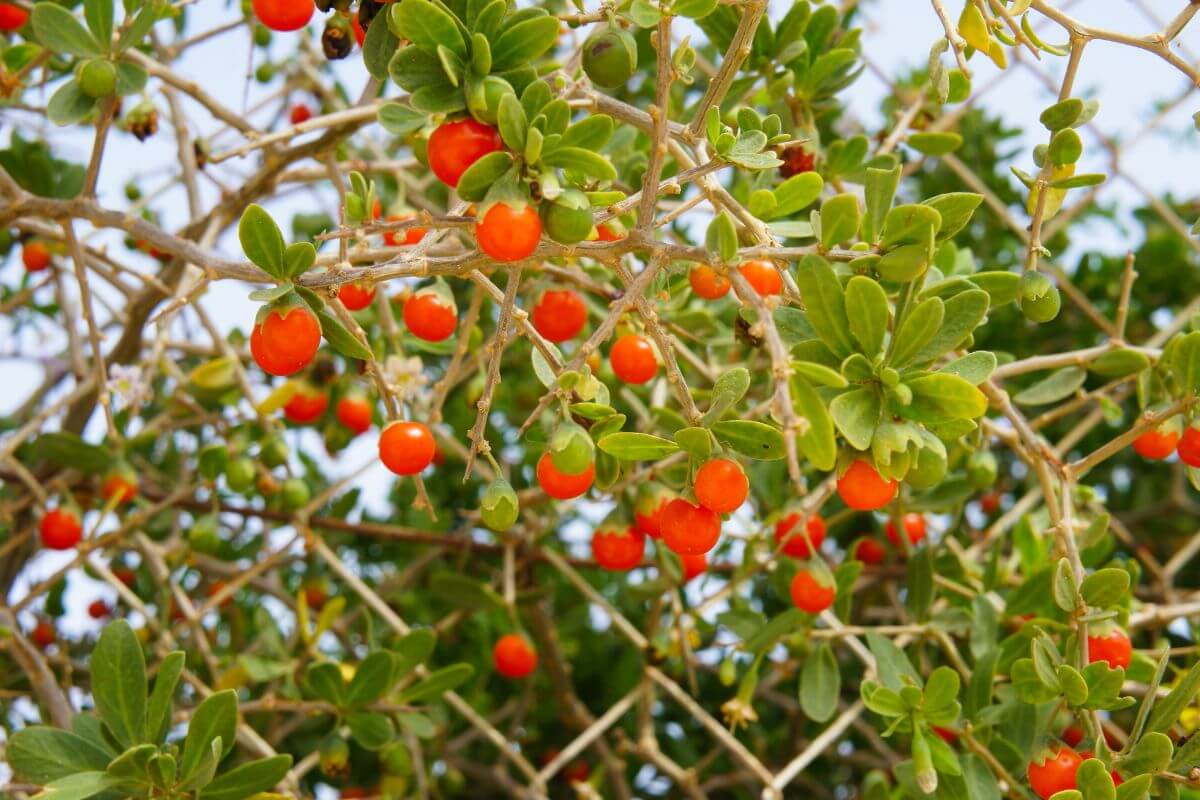
Goji berries, also known as wolfberries, are native to China. Goji berry plants thrive in zones 5 through 9 and do best in full sun or partial shade and well-draining soil.
Although goji production in the U.S. is still experimental, it holds great promise. Once successful, goji berries will make a fantastic addition to your yard. They offer beautiful purple flowers that turn into vibrant berries.
Goji berries have a unique taste. They have the combined flavors of tomato, cranberry, and sour cherry. For an interesting twist, they can be added to fruit salads, cereals, or even hot pepper jellies. Goji berries are packed with antioxidants, vitamins, and nutrients. They are among the healthiest fruits you can grow.
They are now famous worldwide for their health benefits. These berries can boost the immune system. They also help regulate blood sugar and may even have anti-aging properties. However, people on blood thinners should avoid them.
13. Honeyberries (Lonicera caerulea)
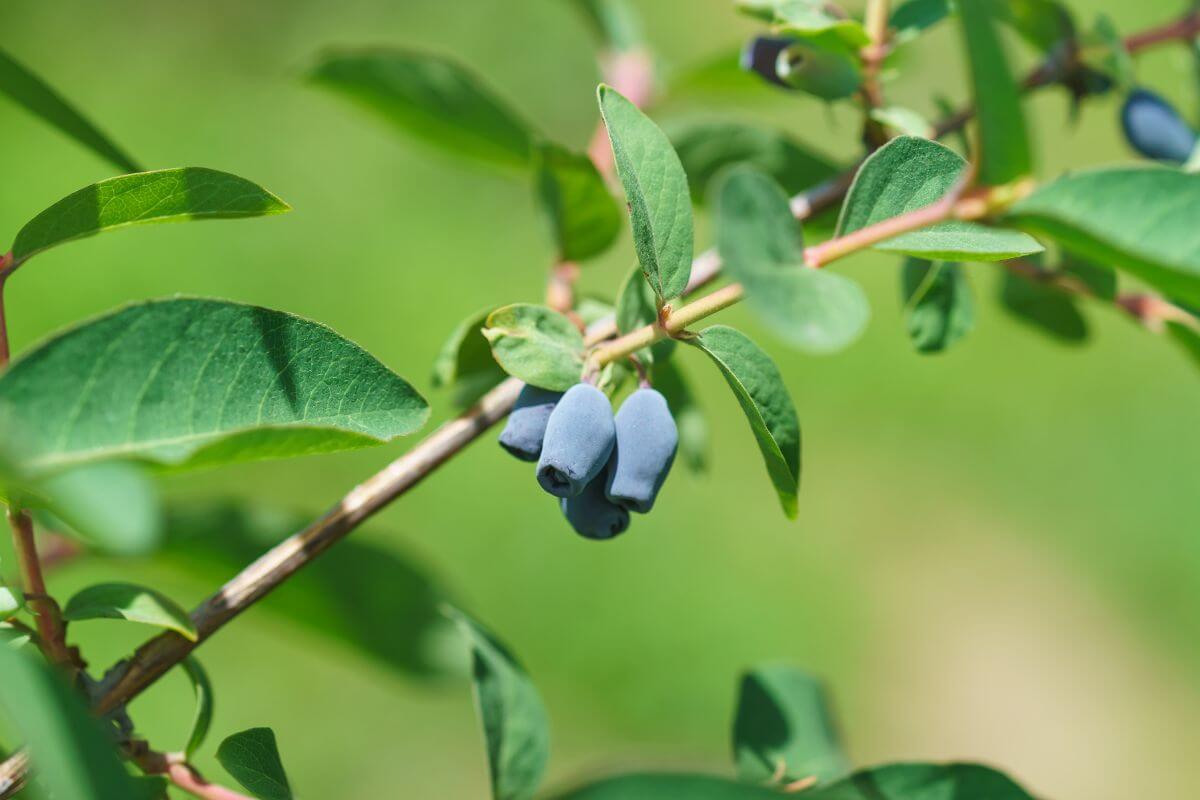
Honeyberry, also known as honeysuckle or haskap, is a type of honeysuckle. It is native to cold regions of Europe, Asia, and North America. These berries are extremely hardy and grow in various zones and climates. They do best in partially sunny locations with moderately acidic soil.
They are hardy and versatile. In the spring, they bloom with pale yellow flowers. Then, the flowers become dark purple berries by summer. These plants yield berries with a taste like blueberry, raspberry, and blackcurrant.
Honeyberries can be enjoyed fresh or used in cooking and baking. They have a sour-sweet, delicious taste. Their rich tartness gives them a unique flavor. It has been likened to a combination of blueberry, blackberry, and raspberry.
They contain antioxidants, calcium, phosphorous, potassium, phenolic acid, and iron. These nutrients contribute to various health benefits. This includes immune support, heart health, and anti-inflammatory effects.
Edible Berry Bushes Final Thoughts
Growing edible berry bushes in your garden or finding them in the wild is a great way to enjoy fresh fruit. Each berry bush type has unique characteristics and can add flavor and beauty to your yard.
Raspberries, blackberries, and blueberries are easy to grow and yield lots of fruit. In contrast, lesser-known berries like goji and honeyberries boast unique flavors and health benefits. These make them intriguing garden choices.
Remember to choose berry bushes that thrive in your specific climate and soil type for a good yield. Experimenting with different types can help you find new favorites for your garden.
To learn more about other edible plants, check out these guides:

